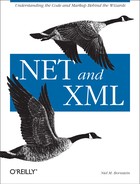Building Requests with Remoting
Even the automatically generated code requires you to write code specifically to serve web service requests. There is one more way to use Web Services to invoke methods across a distributed application. .NET Remoting puts together everything you’ve seen up to this point to form the very heart of .NET’s distributed application framework.
Tip
Remoting refers to a specific form of Web Services that is tuned to work only between .NET applications. You should think of it as a form of Web Services, but not as fitting the purest definition of Web Services, because it depends on specific knowledge of the .NET typing system and assemblies.
There are three major differences between .NET Remoting and the previous Web Services examples. First, although Web Services uses the ASP.NET provider as the web service host, Remoting can run within any .NET application. Second, Remoting does not provide a WSDL file for the service, instead relying on the fact that server and client code are written specifically to work with each other. Finally, Remoting uses the runtime form of SOAP serialization I introduced in Chapter 9 rather than the SOAP serialization that Web Services uses.
The first step in implementing a
Remoting server is to alter the InventoryQuery
class from Example 10-2 as follows. As
you’ll see, the only difference is that
I’ve removed the WebService and
WebMethod attributes, and made
InventoryQuery derive from
MarshalbyRefObject:
using System;
public class InventoryQuery : MarshalByRefObject {
public int GetNumberInStock(string productCode) {
return 0;
}
}The next step is to create a server to listen for requests to the
InventoryQuery object. I’ll call
it InventoryQueryServer, and
here’s the code:
using System;
using System.Runtime.Remoting;
using System.Runtime.Remoting.Channels;
using System.Runtime.Remoting.Channels.Tcp;
public class InventoryQueryServer {
public static void Main(string [ ] args) {
TcpChannel chan = new TcpChannel(8085);
ChannelServices.RegisterChannel(chan);
RemotingConfiguration.RegisterWellKnownServiceType(
Type.GetType("InventoryQuery"),
"GetNumberInStock", WellKnownObjectMode.Singleton);
System.Console.WriteLine("Hit return to exit...");
System.Console.ReadLine( );
}
}This program simply registers the service and waits for client requests. All that’s left now is to write the client code:
using System;
using System.Runtime.Remoting;
using System.Runtime.Remoting.Channels;
using System.Runtime.Remoting.Channels.Tcp;
public class InventoryQueryRemotingClient {
public static void Main(string [ ] args) {
TcpChannel chan = new TcpChannel( );
ChannelServices.RegisterChannel(chan);
InventoryQuery query = (InventoryQuery)Activator.GetObject(
Type.GetType("InventoryQuery"),
"tcp://localhost:8085/GetNumberInStock");
Console.WriteLine(query.GetNumberInStock("803B"));
}
}That’s a fairly sketchy overview of the Remoting
process, but that topic moves beyond this book’s
realm. Programming.NET
Components by Juval Löwy
(O’Reilly) covers the topic more thoroughly than I
can here.
